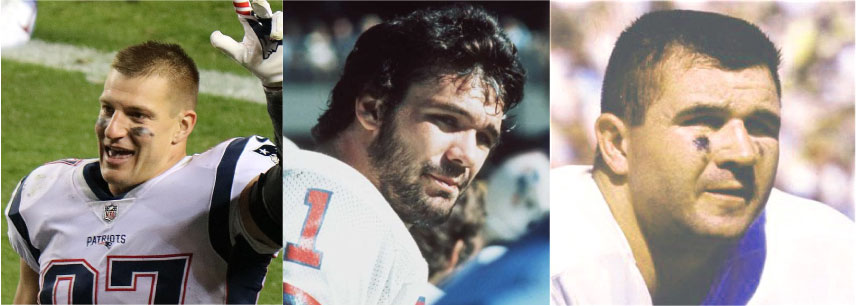SCORES & OUTDOORS: Gronk, and the evolution of the tight end position in the NFL
 by Roland D. Hallee
by Roland D. Hallee
An era has ended in New England. Heck, it has ended throughout the United States. Rob Gronkowski, the happy-go-lucky, larger-than-life, bruising tight end for the New England Patriots has announced his retirement following nine seasons in the National Football League. Patriots fans lament his decision, while the rest of the league breathes a collective sigh of relief now that they don’t have to deal with the constant downfield threat.
I met Gronk once, right after his rookie season. A massive human being with a jovial personality, his hand enveloped mine and almost crushed every bone during a vigorous and aggressive handshake. I lost that one. I have met many professional sports athletes, but the encounter with Gronk is one that comes to the forefront of memories.
Chosen in the second round of the 2010 draft, the 42nd player picked overall, Gronk went on to a stellar career. The 6-foot 6-inch, 268-pound tight end amassed 521 career receptions, 7,861 receiving yards and 79 receiving touchdowns as a player. Along with that, he played on three Super Bowl-winning Patriots teams, was chosen to five Pro Bowls, four-time All Pro, and NFL comeback player of the year in 2014. He is a shoe-in for the NFL Hall of Fame.
With the many accomplishments and accolades, Gronkowski is regarded by many sports analysts, writers and peers as not only one of the the finest players in the league, but the greatest tight end to ever play the game.
But, the position of tight end was revolutionized a long time ago by another Patriots player.
Russ Francis, a 6-foot, 6-inch, 242-pound tight end with the Patriots, changed the position’s importance back in the 1970s.
Drafted out of the University of Oregon in 1975, in the first round, the 16th overall pick, he went on to become the premiere tight end of his era. He played seven seasons with the Patriots and six seasons with the San Francisco 49ers, where he was a member of the Super Bowl XIX champions in 1984.
During the 1976 season, in the Patriots 30-27 victory over the Pittsburgh Steelers, the defending Super Bowl champions, Francis caught a 38-yard touchdown pass from Steve Grogan on a fourth and one. In that game, Francis had a career-best 139 receiving yards, prompting sportscaster Howard Cosell to proclaim him as the “All-World Tight End.”
Francis was a Pro Bowl selection for three consecutive seasons from 1977-79.
However, many years prior to Russ Francis coming onto the scene, there was another man who made a mark as a tight end in the NFL.
Mike Ditka arrived in the National Football League in 1961 out of the University of Pittsburgh. The 6-foot, 3-inch, 228-pound Ditka was nicknamed “Iron Mike,” perhaps because he was born and raised in a steel town in Pennsylvania. But Ditka had a nasty side to him that shook the league. He was the fifth pick overall in the 1961 college draft, by the Chicago Bears. He had the distinction of having been picked in the first round of both the NFL, and the American Football League, rival leagues at the time.
In his inaugural season in the NFL, he had 58 receptions, introducing a new dimension to a tight end position which had previously been dedicated to blocking. He was selected rookie of the year. He went on to play for the Philadelphia Eagles and Dallas Cowboys, and was inducted into the Pro Football Hall of Fame in 1988, becoming the first tight end to do so. Ditka totaled 4,503 yards (ranking him first in Bears history), 316 receptions and 34 touchdowns.
When his playing days were over, he became an assistant coach with the Cowboys in 1972, where he was a member of the Super Bowl winning team, in 1977. From there he went on to coach the Chicago Bears, where he won a Super Bowl in 1986, becoming one of only two men to win a Super Bowl as a player, assistant coach and head coach. Mike Flores is the other. Ditka, Flores, Gary Kubiak and Doug Pederson are also the only people in modern NFL history to win a championship as head coach of a team for which he once played.
There are other tight ends around the NFL that are mentioned when discussions arise about the tight end position. But, in my opinion, these are the three that stand out as having the largest impact on the position from how it was once utilized, to the importance it now represents in the modern offensive schemes in the league. Gronk is, without a doubt, a member of an elite trio responsible for that.
Roland’s trivia question of the week:
Where did Rob Gronkowski play his college football?
Responsible journalism is hard work!
It is also expensive!
If you enjoy reading The Town Line and the good news we bring you each week, would you consider a donation to help us continue the work we’re doing?
The Town Line is a 501(c)(3) nonprofit private foundation, and all donations are tax deductible under the Internal Revenue Service code.
To help, please visit our online donation page or mail a check payable to The Town Line, PO Box 89, South China, ME 04358. Your contribution is appreciated!



Leave a Reply
Want to join the discussion?Feel free to contribute!